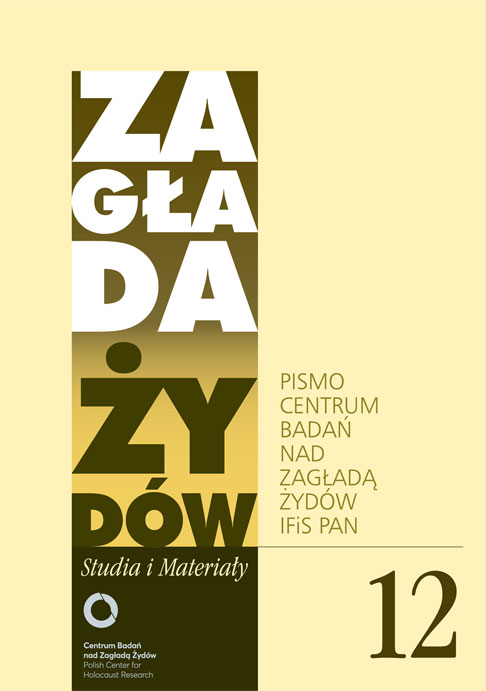Pomoc udzielana Żydom przez zakony we Francji podczas Zagłady. Wprowadzenie do zagadnienia
Zagłada Żydów. Studia i Materiały, Nr 12 (2016), Strony: 169-186
Data zgłoszenia: 2020-10-19Data publikacji: 2016-11-30
 https://doi.org/10.32927/ZZSiM.411
https://doi.org/10.32927/ZZSiM.411
Abstrakt
During the Holocaust, an undetermined number of Roman Catholic male and fe- male religious belonging to various Orders, Congregations and Societies helped Jews. Some were involved in hiding Jewish men, women, and children by placing them in their cloisters, guesthouses, nurseries, retirement homes and parishes assigned to them or arranged their placement in private homes or in other com- munities’ institutions. Some assisted Jews by providing false identiϐication or food ration cards, or assisted them in illegally crossing the border. Their lifestyle had an inϐluence on how assistance was conducted. Male and female religious lived and worked within a socio-economic communal system according to the norms of the particular community characterized by a life of prayer, work and living within some form of communal structure. This article presents different types of communities vis-à-vis the hiding Jews by religious in France, the issues of superiors, and the variant internal organizational procedures as to how assis- tance was organized, while taking into consideration that religious who helped Jews were members of communal and social entities and who often utilized their community’s resources in the assistance offered.
Słowa kluczowe
zakony , wspólnoty religijne , ukrywanie Żydów , Francja
Licencja
Prawa autorskie (c) 2016 Autor&"Zagłada Żydów. Studia i Materiały"

Utwór dostępny jest na licencji Creative Commons Uznanie autorstwa 4.0 Międzynarodowe.
https://creativecommons.org/licenses/by/4.0
Czasopismo publikowane jest w standardzie Diamond Open Access na licencji CC-BY-4.0 Deed - Uznanie autorstwa 4.0 Międzynarodowa - Creative Commons
Podobne artykuły
- Marta Tomczok, Kinga Piotrowiak-Junkiert, Świadomość zwrócona przeciwko sobie samej. Imre Kertész wobec Zagłady , Zagłada Żydów. Studia i Materiały: Nr 12 (2016)
- Katharina Friedla, Angelika Benz, Handlanger der SS. Die Rolle der Trawniki-Männer im Holocaust , Zagłada Żydów. Studia i Materiały: Nr 12 (2016)
- Piotr Forecki, Muzeum zgody w Markowej , Zagłada Żydów. Studia i Materiały: Nr 12 (2016)
- Przemysław Nowicki, Łucja Pawlicka-Nowak (1938–2020) – badaczka Zagłady, prekursorka archeologii miejsc pamięci , Zagłada Żydów. Studia i Materiały: Nr 16 (2020)
- Katarzyna Odrzywołek, Piotr Trojański, Dzieci Teheranu – od mrozów Syberii do słońca Palestyny. Rola delegatur Ambasady RP w ZSRR i Armii gen. Andersa w ratowaniu dzieci żydowskich , Zagłada Żydów. Studia i Materiały: Nr 11 (2015)
- Dagmara Swałtek-Niewińska, Salomon Greiwer i Warsztaty Miejskie w Bochni , Zagłada Żydów. Studia i Materiały: Nr 12 (2016)
- Jan H. Issinger, Frankenstein w warszawskim getcie. Historia i legenda , Zagłada Żydów. Studia i Materiały: Nr 12 (2016)
- Adam Sitarek, Danuta Dąbrowska – pionierka badań nad łódzkim gettem , Zagłada Żydów. Studia i Materiały: Nr 16 (2020)
- Marta Tomczok, Anna Mach, Świadkowie świadectw. Postpamięć Zagłady w polskiej literaturze najnowszej; Małgorzata Wójcik-Dudek, W(y)czytać Zagładę. Praktyki postpamięci w polskiej literaturze XXI wieku dla dzieci i młodzieży , Zagłada Żydów. Studia i Materiały: Nr 13 (2017)
- Zofia Wóycicka, Sarah Gunsburger, National Policy, Global Memory: The Commemoration of the „Righteous” from Jerusalem to Paris, 1942–2007 , Zagłada Żydów. Studia i Materiały: Nr 13 (2017)
<< < 23 24 25 26 27 28 29 30 31 32 33 34 35 36 37 38 39 40 41 42 43 44 45 46 47 48 49 50 51 52 53 54 55 56 57 > >>
Możesz również Rozpocznij zaawansowane wyszukiwanie podobieństw dla tego artykułu.
 English
English
 Język Polski
Język Polski




